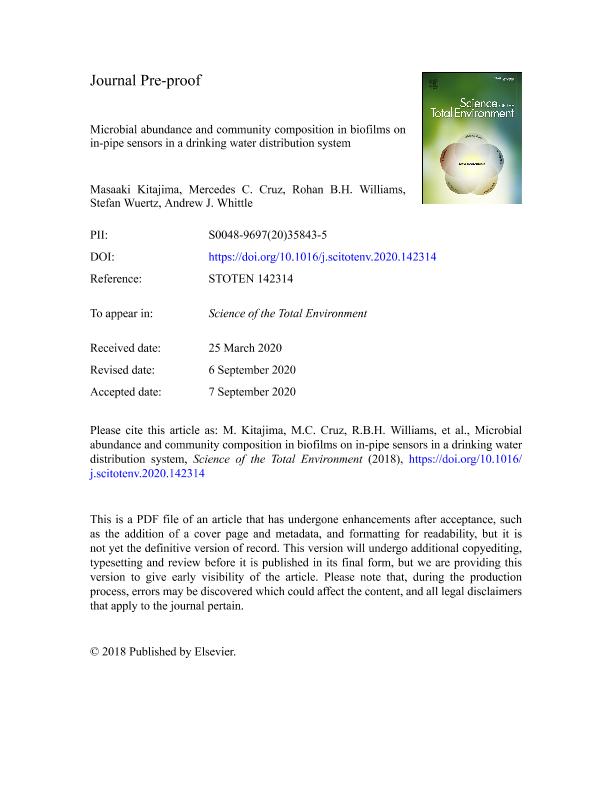Mostrar el registro sencillo del ítem
dc.contributor.author
Kitajima, Masaaki
dc.contributor.author
Cruz, Mercedes Cecilia

dc.contributor.author
Williams, Rohan Benjamin Hugh
dc.contributor.author
Wuertz, Stefan

dc.contributor.author
Whittle, Andrew J.
dc.date.available
2021-09-09T16:12:02Z
dc.date.issued
2020-09
dc.identifier.citation
Kitajima, Masaaki; Cruz, Mercedes Cecilia; Williams, Rohan Benjamin Hugh; Wuertz, Stefan; Whittle, Andrew J.; Microbial abundance and community composition in biofilms on in-pipe sensors in a drinking water distribution system; Elsevier; Science of the Total Environment; 766; 142314; 9-2020; 1-37
dc.identifier.issn
0048-9697
dc.identifier.uri
http://hdl.handle.net/11336/140014
dc.description.abstract
Collecting biofilm samples from drinking water distribution systems (DWDSs) is challenging due to limited access to the pipes during regular operations. We report here the analysis of microbial communities in biofilm and water samples collected from sensors installed in a DWDS where monochloramine is used as a residual disinfectant. A total of 52 biofilm samples and 14 bulk water samples were collected from 17 pipe sections representing different water ages. Prokaryotic genome copies (bacterial and archaeal 16S rRNA genes, Mycobacterium spp., ammonia-oxidizing bacteria (AOB), and cyanobacteria) were quantified with droplet digital PCR, which revealed the abundance of these genes in both biofilm and water samples. Prokaryotic 16S rRNA gene sequencing analysis was carried out for a subset of the samples (12 samples from four sites). Mycobacterium and AOB species were dominant in the DWDS sections with low water age and sufficient residual monochloramine, whereas Nitrospira species (nitrite-oxidizing bacteria) dominated in the sections with higher water age and depleted monochloramine level, suggesting the occurrence of nitrification in the studied DWDS. The present study provides novel information on the abundance and identity of prokaryotes in biofilms and water in a full-scale operational DWDS.
dc.description.abstract
Collecting biofilm samples from drinking water distribution systems (DWDSs) is challenging due to limited access to the pipes during regular operations. We report here the analysis of microbial communities in biofilm and water samples collected from sensors installed in a DWDS where monochloramine is used as a residual disinfectant. A total of 52 biofilm samples and 14 bulk water samples were collected from 17 pipe sections representing different water ages. Prokaryotic genome copies (bacterial and archaeal 16S rRNA genes, Mycobacterium spp., ammonia-oxidizing bacteria (AOB), and cyanobacteria) were quantified with droplet digital PCR, which revealed the abundance of these genes in both biofilm and water samples. Prokaryotic 16S rRNA gene sequencing analysis was carried out for a subset of the samples (12 samples from four sites). Mycobacterium and AOB species were dominant in the DWDS sections with low water age and sufficient residual monochloramine, whereas Nitrospira species (nitrite-oxidizing bacteria) dominated in the sections with higher water age and depleted monochloramine level, suggesting the occurrence of nitrification in the studied DWDS. The present study provides novel information on the abundance and identity of prokaryotes in biofilms and water in a full-scale operational DWDS
dc.format
application/pdf
dc.language.iso
eng
dc.publisher
Elsevier

dc.rights
info:eu-repo/semantics/openAccess
dc.rights.uri
https://creativecommons.org/licenses/by-nc-sa/2.5/ar/
dc.subject
WATER DISTRIBUTION SYSTEM
dc.subject
BIOFILM
dc.subject
WATER QUALITY
dc.subject
16S RNA GENE SEQUENCING
dc.subject.classification
Bioremediación, Diagnóstico Biotecnológico en Gestión Medioambiental

dc.subject.classification
Biotecnología del Medio Ambiente

dc.subject.classification
INGENIERÍAS Y TECNOLOGÍAS

dc.title
Microbial abundance and community composition in biofilms on in-pipe sensors in a drinking water distribution system
dc.type
info:eu-repo/semantics/article
dc.type
info:ar-repo/semantics/artículo
dc.type
info:eu-repo/semantics/publishedVersion
dc.date.updated
2021-04-28T20:38:53Z
dc.journal.volume
766
dc.journal.number
142314
dc.journal.pagination
1-37
dc.journal.pais
Países Bajos

dc.description.fil
Fil: Kitajima, Masaaki. Hokkaido University; Japón. Singapore-MIT Alliance for Research and Technology; Singapur
dc.description.fil
Fil: Cruz, Mercedes Cecilia. Consejo Nacional de Investigaciones Científicas y Técnicas. Centro Científico Tecnológico Conicet - Salta. Instituto de Investigaciones para la Industria Química. Universidad Nacional de Salta. Facultad de Ingeniería. Instituto de Investigaciones para la Industria Química; Argentina. Nanyang Technological University; Singapur
dc.description.fil
Fil: Williams, Rohan Benjamin Hugh. National University of Singapore; Singapur
dc.description.fil
Fil: Wuertz, Stefan. National University of Singapore; Singapur. Nanyang Technological University; Singapur
dc.description.fil
Fil: Whittle, Andrew J.. Singapore-MIT Alliance for Research and Technology; Singapur. Massachusetts Institute of Technology; Estados Unidos
dc.journal.title
Science of the Total Environment

dc.relation.alternativeid
info:eu-repo/semantics/altIdentifier/doi/http://dx.doi.org/10.1016/j.scitotenv.2020.142314
dc.relation.alternativeid
info:eu-repo/semantics/altIdentifier/url/https://www.sciencedirect.com/science/article/abs/pii/S0048969720358435
Archivos asociados
